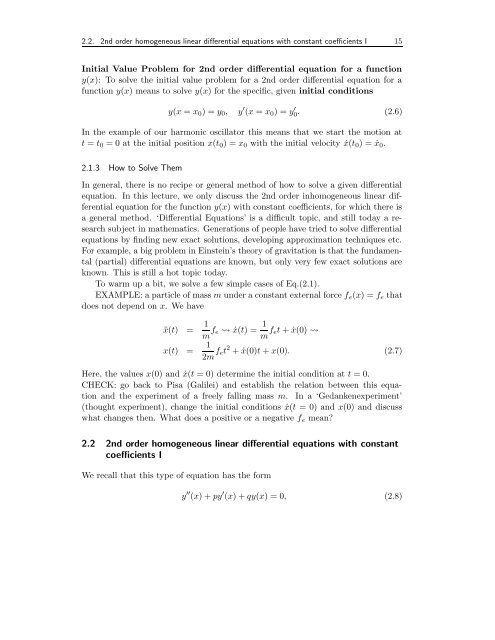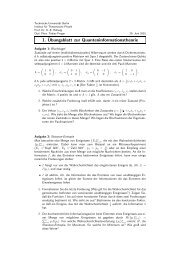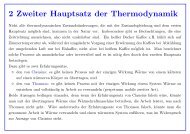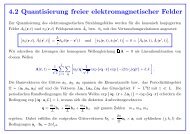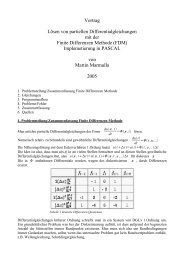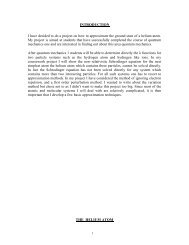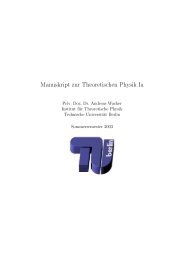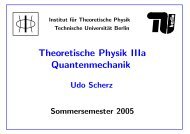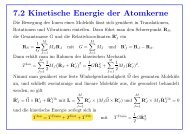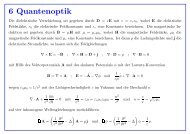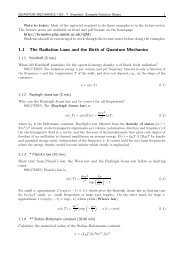2. SECOND ORDER LINEAR DIFFERENTIAL EQUATIONS
2. SECOND ORDER LINEAR DIFFERENTIAL EQUATIONS
2. SECOND ORDER LINEAR DIFFERENTIAL EQUATIONS
Create successful ePaper yourself
Turn your PDF publications into a flip-book with our unique Google optimized e-Paper software.
<strong>2.</strong><strong>2.</strong> 2nd order homogeneous linear differential equations with constant coefficients I 15<br />
Initial Value Problem for 2nd order differential equation for a function<br />
y(x): To solve the initial value problem for a 2nd order differential equation for a<br />
function y(x) means to solve y(x) for the specific, given initial conditions<br />
y(x = x0) = y0, y ′ (x = x0) = y ′ 0 . (<strong>2.</strong>6)<br />
In the example of our harmonic oscillator this means that we start the motion at<br />
t = t0 = 0 at the initial position x(t0) = x0 with the initial velocity ˙x(t0) = ˙x0.<br />
<strong>2.</strong>1.3 How to Solve Them<br />
In general, there is no recipe or general method of how to solve a given differential<br />
equation. In this lecture, we only discuss the 2nd order inhomogeneous linear differential<br />
equation for the function y(x) with constant coefficients, for which there is<br />
a general method. ‘Differential Equations’ is a difficult topic, and still today a research<br />
subject in mathematics. Generations of people have tried to solve differential<br />
equations by finding new exact solutions, developing approximation techniques etc.<br />
For example, a big problem in Einstein’s theory of gravitation is that the fundamental<br />
(partial) differential equations are known, but only very few exact solutions are<br />
known. This is still a hot topic today.<br />
To warm up a bit, we solve a few simple cases of Eq.(<strong>2.</strong>1).<br />
EXAMPLE: a particle of mass m under a constant external force fe(x) = fe that<br />
does not depend on x. We have<br />
¨x(t) = 1<br />
m fe ˙x(t) = 1<br />
m fet + ˙x(0) <br />
x(t) = 1<br />
2m fet 2 + ˙x(0)t + x(0). (<strong>2.</strong>7)<br />
Here, the values x(0) and ˙x(t = 0) determine the initial condition at t = 0.<br />
CHECK: go back to Pisa (Galilei) and establish the relation between this equation<br />
and the experiment of a freely falling mass m. In a ‘Gedankenexperiment’<br />
(thought experiment), change the initial conditions ˙x(t = 0) and x(0) and discuss<br />
what changes then. What does a positive or a negative fe mean?<br />
<strong>2.</strong>2 2nd order homogeneous linear differential equations with constant<br />
coefficients I<br />
We recall that this type of equation has the form<br />
y ′′ (x) + py ′ (x) + qy(x) = 0, (<strong>2.</strong>8)


